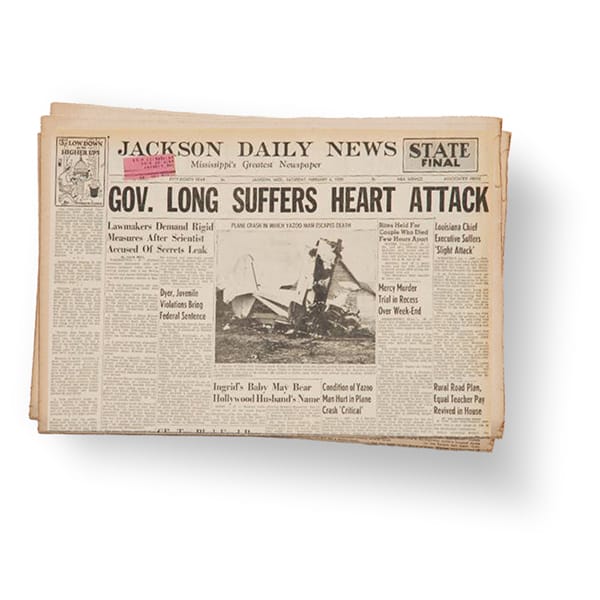1945 Newspaper Headlines
1945 was an incredibly significant year for the whole world. But what happened in 1945 to make this year so important? 1945 saw the official end of World War II, as the Allied and Soviet forces stormed Germany, liberating concentration camps, closing in on Berlin, and initiating the Nazi surrender. Adolf Hitler and his wife of just one day, Eva Braun, commit suicide in the bunker they were hiding in moments before the Soviets could reach them.
The final allied leadership conference would take place a while later, and Stalin, Churchill and Truman would meet to discuss the end of World War II and how to proceed at the Potsdam Conference. World War II had ended, but there was a long road ahead to recuperation from the turmoil and destruction it had left in its wake. These 1945 newspaper articles explore what happened during the end of World War II and its aftermath, and paint a clear picture of how it felt to be there at the time.
January 20, 1945
Franklin D. Roosevelt is inaugurated to an unprecedented fourth term as President. No president before, or since, has ever reached a third term in office.
January 27, 1945
The Second World War Holocaust: The Auschwitz and Birkenau concentration camps are liberated by the 322nd Rifle Division of the Red (Soviet Union) Army.
February 4, 1945
President Franklin D. Roosevelt, Prime Minister Winston Churchill and Soviet leader Joseph Stalin begin the week-long Yalta Conference, during which they discuss Europe’s post-war organisation.
February 13, 1945
The Royal Air Force bombs Dresden in Germany.
February 23, 1945
The Battle of Iwo Jima: A group of United States Marines reach the top of Mount Suribachi on the island and are photographed raising the American flag. The photo taken by Joe Rosenthal, Raising the Flag, later wins a Pulitzer Prize.
February 1945
Annelies Marie “Anne” Frank dies in the Bergen-Belsen concentration camp, following an outbreak of typhus in the prison. She later gains posthumous fame due to the publication of the diary that she had written whilst hiding during the German occupation of the Netherlands.
March 4, 1945
Princess Elizabeth, later Queen Elizabeth II, joins the British Army as a driver.
April 12, 1945
President Franklin Delano Roosevelt (b. 1882) dies suddenly at Warm Springs in Georgia; Vice President Harry S. Truman becomes the 33rd President.
April 28, 1945
Italian dictator Benito Mussolini and his mistress Clara Petacci are executed by Italian partisans as they attempt to flee the country. Their bodies are then hung by their heels in the public square of Milan.
30th April 1945
Adolf Hitler and his wife of one day, Eva Braun, commit suicide as the Red Army approaches the Führerbunker in Berlin. Karl Dönitz succeeds Hitler as President of Germany and Joseph Goebbels briefly succeeds Hitler as Chancellor of Germany, before his own suicide the following evening.
8th May 1945
Nazi Germany surrenders and V-E Day (Victory in Europe Day) commemorates the end of the Second World War.
July 16, 1945
The Trinity test detonates the world’s first atomic bomb.
July 21, 1945
President Harry Truman approves the order for atomic bombs to be used against Japan.
July 26, 1945
Winston Churchill resigns as Britain’s Prime Minister after his Conservative Party is soundly defeated by the Labour Party in the 1945 general election. Clement Attlee becomes the new Prime Minister.
August 6, 1945
The United States detonates an atomic bomb nicknamed “Little Boy” on the Japanese City of Hiroshima. The bomb explodes at 08.15am local time and instantly kills 80,000 people. By the end of the year, many more thousands of fatalities are recorded due to radiation poisoning. This was the first atomic bomb used on civilians.
September 2, 1945
The official end of the Second World War: The final surrender of Japan, from a delegation aboard the battleship ‘Missouri’, is accepted by Supreme Allied Commander General Douglas MacArthur and Fleet Admiral Chester Nimitz.
October 24, 1945
The United Nations is founded.
November 29, 1945
Assembly of the world’s first general purpose electronic computer, the Electronic Numerical Integrator and Computer (ENIAC), is completed. It covers 1,800 square feet (170 m2) of floor space.
December 4, 1945
The United States Senate approves the entry of the United States into the United Nations by a vote of 65-7.
More from this Decade

